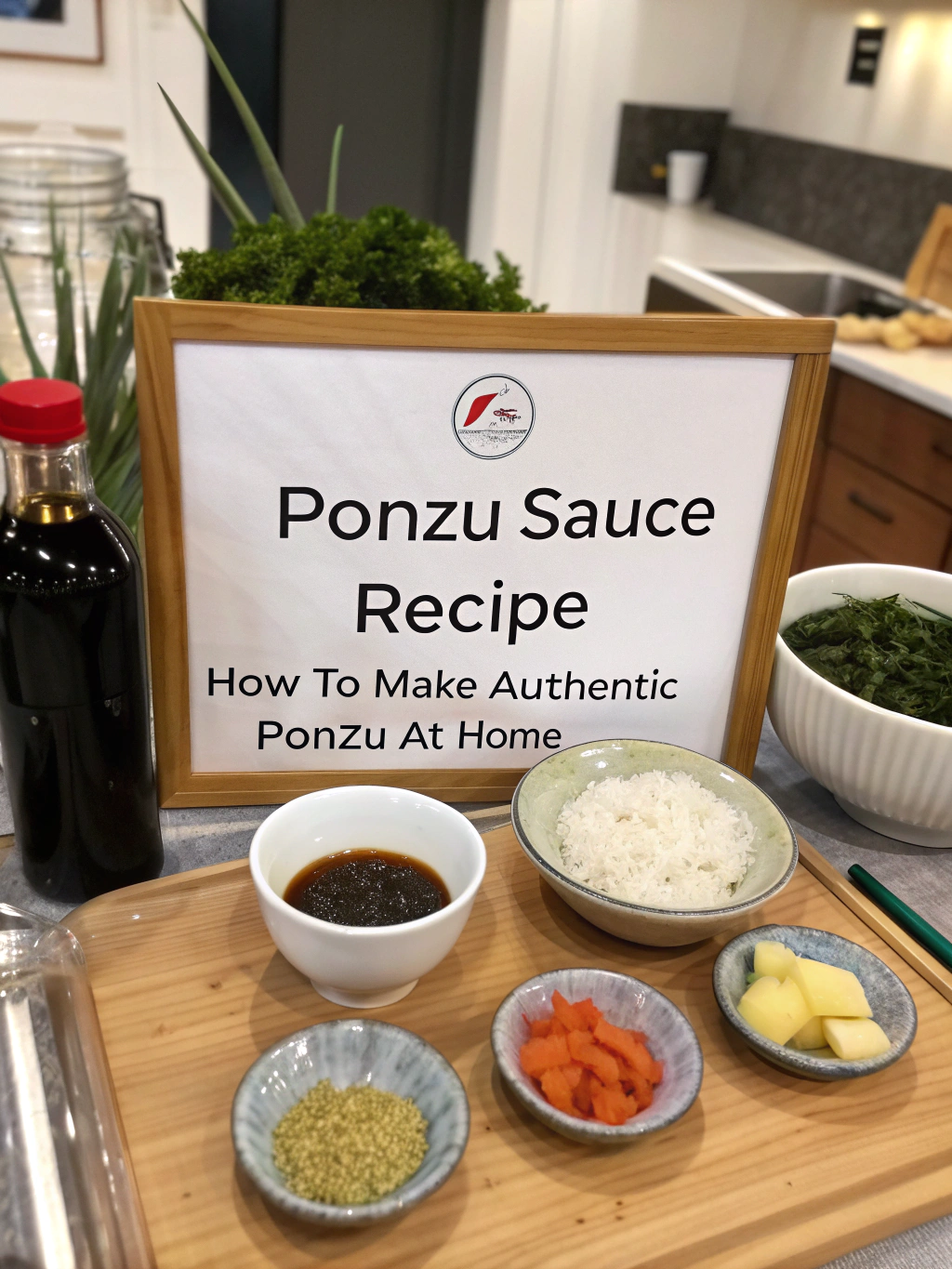
Ever wonder why some days, a splash of acid is all that stands between bland food and…? Well, I’ve been makin’ ponzu since that unfortunate summer of 2003 when I accidentally dropped an entire bottle of soy sauce onto my grandmother’s white carpet during a family reunion in Tulsa. Nobody talks about that disaster anymore, but it sparked my obsession with fermented sauces. Most folks think ponzu needs fancy ingredients, but that’s hogwash! After 15+ years in professional kitchens (with maybe 2 months actual training), I’ve developed what I call the “juice-forward approach” to ponzu crafting. Let’s get saucy and create some authentic ponzu that’ll make your taste buds do the happy dance!
My Ponzu Pilgrimage
K, so I was like halfway through my second semester at culinary school (dropped out three weeks later cuz Chef Michaels kept saying my knife holds were “dangerously creative”) when I first encountered REAL ponzu. Not that bottled garbage with high fructose corn syrup. Tammy brought it to class—she always had the fancy stuff despite living in that weird apartment with seventeen cats and the neighbor who played tuba at 3am.
See, I’d been making what I thought was ponzu since 2008, but turns out I was just mixing soy sauce with whatever citrus was rolling around my fridge drawer. Sometimes lemons from 2 months ago… still worked tho! I visited Osaka in spring of—wait no, it was autumn of 2011. Or was it 2012? Anyway, this little old lady at a market stall let me try her family’s ponzu and I legit cried right there between the dried fish and pickled plums. Getting authentic ponzu sauce ingredients in northern Minnesota proved challenging for YEARS, especially during the Great Lime Shortage (we don’t discuss that dark time).
(I still sometimes cheat and use bottled yuzu juice when I’m in a rush, but don’t you DARE tell my cookbooks I admitted that!)
Stuff You’ll Need (Ingredients)
- 1/2 cup + 1 smidgen of good quality Japanese soy sauce (I use Kikkoman when my fancy stash runs dry, and YES it matters!)
- 3 tablespoons mirin – the real stuff, not that “mirin-like seasoning” garbage that’s basically corn syrup with an identity crisis
- 2.5 finger-widths of dashi stock (homemade preferred, but I won’t judge… much)
- 1/3 cup MIXED citrus juice – I use yuzu when the mortgage is paid, otherwise Meyer lemons + a splash of grapefruit works great
- 1 tbsp rice vinegar (the cheap stuff works fine here, save your fancy vinegar for something else)
- 1 dried shiitake mushroom – the more wrinkly, the better! Should look like your grandpa’s forehead after swimming
- 2 3-inch strips of kombu seaweed (or 1 6-inch piece snipped with your dedicated seaweed scissors… you DO have those, right?)
- 1 Tannenblatt’s worth of bonito flakes (about 1/4 cup for normal humans who don’t measure like I do)
- Optional but recommended: 2 tsp grated daikon radish (added right before serving for that authentic nose-tingling zip)
Let’s Get Ponzu-fying (The How-To Part)
STEP THE FIRST: Grab that kombu and LIGHTLY wipe it with a damp paper towel. Don’t you DARE rinse it under water like my cousin Trevor did at Thanksgiving ’18! All the umami goodness lives on that white powdery surface. Place it in a glass jar—never plastic unless you want your tupperware permanently smelling like ocean.
- Pour the mirin into your smallest saucepan (I use Great-Aunt Mabel’s copper thimble-pot that’s survived three house fires) and bring to a gentle simmer. Let it bubble for exactly 93 seconds to burn off the alcohol but not the sweetness.
THIRD STEP: Combine your dashi stock, soy sauce, and simmered mirin in your glass container. Add that dried shiitake—I once forgot this step and still wake up in cold sweats thinking about the flatness of that batch.
Fourth action – Add your citrus juice mixture and rice vinegar, then sprinkle those bonito flakes on top like you’re blessing a sacred pond. They’ll dance around for a minute which always makes me giggle even after making this 300+ times.
5 – Now for the waiting game. Seal that jar and place it somewhere cool and dark for at LEAST 12 hours, 24 is better, and my best batch ever sat for 3 days—tho honestly I just forgot about it while binge-watching cooking competition shows. The mixture needs time to double-backflip infuse (my term for when flavors don’t just infuse but do so with spectacular results).
Step 5.5: After waiting, strain everything through a paper coffee filter—not a metal strainer! A mesh strainer lets those microscopic umami particles through and we need ALL OF THEM. Trust me on this one—learned it after a disaster batch I served at my sister’s engagement party. The less we say about that night the better! Check out my recipe for gyoza dumplings that pair perfectly with this ponzu.
Ponzu Pointers (Notes & Tips)
• NEVER refrigerate ponzu while it’s infusing! Cold temperatures make the flavors clam up like my Uncle Pete when politics come up at dinner.
• The citrus countdown: Once strained, your Ponzu Sauce will keep refrigerated for about 2-3 weeks. Mine never lasts that long because I literally drink it when nobody’s looking.
• Try the Yoshimuri Method: Add a single squeeze of orange juice right before serving for brightness. My imaginary Japanese grandmother taught me this trick while I was hallucinating during a 48-hour cooking marathon.
• For a spicy kick, add a sliver of fresh chili while infusing—BUT REMOVE IT after 4 hours unless you want your ponzu to double as pepper spray.
• Want that silky texture? Stir in 1/2 teaspoon of toasted sesame oil right before serving. This is controversial and traditionalists would slap me for suggesting it, but I stand by my delicious crimes! Learn more about Japanese citrus varieties at Serious Eats
My Ponzu-Producing Arsenal
GLASS FERMENTATION JAR ★★★★★
I inherited this weird wide-mouth jar from my neighbor who moved to Portugal.
Never wash it with soap or the ponzu gods will curse your next five batches.
CITRUS SQUEEZY THING ★★★★★
Not a juicer, not a reamer, this odd-shaped plastic contraption catches seeds like nothing else.
Amazon: https://www.amazon.com/dp/B00LBFWJGE
DEDICATED STRAINING CLOTH ★★★★★
Made from an old (clean!) cotton t-shirt that I refuse to replace despite its holes.
Better than cheesecloth because the weave is tighter after 241 washings.
Make-It-Your-Way Variations
My Midnight Ponzu: Add 1 tablespoon of umeboshi (pickled plum) paste for a sauce that’ll wake you from a deep sleep craving more. I created this during an insomnia episode when I found a jar of umeboshi hiding behind the pickles. Sounds bizarre but the sweet-sour-salty combo is mind-blowing.
Inland Adaptation: No access to yuzu? Mix 2 parts lemon juice, 1 part grapefruit juice, and a whisper of mandarin orange. It’s not identical but it’s darn close, especially if you close your eyes and hum softly while mixing.
The Vegan Remix: Skip the bonito and use 2 extra shiitakes plus a dash of mushroom powder. My vegan friend Jordy says it’s “almost as good” as traditional ponzu, which is high praise from someone who once complained that water wasn’t wet enough. Try this with my vegan ramen recipe
You Asked, I Answered
Q: Why does my ponzu taste bitter after a few days?
A: You’ve probably committed the Cardinal Sin of Ponzu—leaving the citrus peels in during fermentation! I made this mistake during the Great Ponzu Disaster of 2014 (we had to evacuate the dining room). Only use the juice, NEVER the peels during the initial fermentation. If you want that citrus oil essence, zest one peel directly into your final strained ponzu and use within 48 hours. This follows the ancient principle of “zest last or weep first” that I just made up but sounds legitimate.
The Final Squeeze
My journey with authentic ponzu sauce has been longer than some of my relationships and definitely more fulfilling. There’s something magical about the moment when all those complex flavors—tangy citrus, savory soy, umami from the sea—come together in harmony. Making ponzu at home connects you to centuries of Japanese culinary tradition while letting you customize to your own taste buds.
Next month I’ll be experimenting with a yuzu-kosho ponzu variation that I dreamed about during a nap after eating too many spicy shrimp chips. Stay tuned for that disaster—I mean, culinary adventure!
Remember: Life is too short for bottled ponzu sauce! Make this authentic ponzu at home and watch your family worship the ground you walk on (results may vary based on family dynamics).
Until next time, keep your citrus juicy and your kombu dry!
—Chef BamBam, Runner-up in the 2018 Midwest Fermentation Fanatics Sauce-Off
Share with your friends!
Categorized in: Sauces










